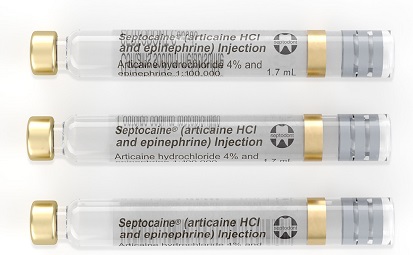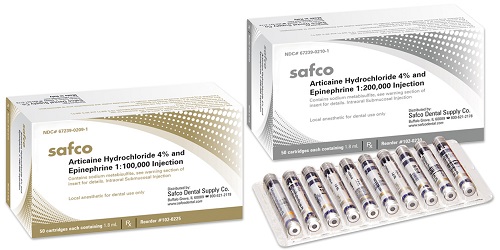
手機掃碼訪問本站

微信咨詢
Articaine (Septocaine) 1:100,000 epinephrine was approved for use in the United States in 2000. It is 1.5 times as potent as lidocaine, and relatively equal in toxicity to lidocaine and mepivacaine. It provides intermediate duration of action of approximately 60 to 75 minutes of pulpal anesthesia and 3 to 6 hours of soft tissue anesthesia.

Articaine [4-methyl-3-(2-propylaminopropionamido) thiophene-2-carboxylic acid methyl ester hydrochloride] has been widely used in dentistry since its approval by the U.S. FDA in the year 2000 because of its quick onset and short duration of action. The structure of articaine differs from those of all other amino amide-type local anesthetics in that it contains a thiophene ring instead of a benzene ring and a carbomethoxy group. This renders the molecule more lipophilic and, thus, easier to cross any lipoidal membranes.
Its local anesthetic potency is approximately 1.5-fold that of lidocaine, even though it has similar pKa (7.8) and plasma protein binding (76%) properties. Articaine also is metabolized primarily by plasma cholinesterases because of the presence of an ester group and, therefore, has a much shorter duration of action than lidocaine (i.e., only approximately one-fourth that of lidocaine). Articaine undergoes rapid hydrolysis of the carbomethoxy group to give articainic acid, which is eliminated either unchanged (75%) or as its glucuronides (25%). Compared with to other short acting, amino amide-type local anesthetics, such as mepivacaine, lidocaine, or prilocaine, articaine is said to be a much safer drug for regional anesthesia and is the drug of choice for dental procedures.

3-α-Chloropropionylamino-2-carbomethoxy-4-methylthiophene (prepared from 3-amino-2-carbomethoxy-4-methylthiophene and chloropropionyl chloride) was dissolved in toluene and n-propylamine added. The whole mixture was heated to boiling for 6 to 7 hours. After cooling, the propylamine hydrochloride that had formed was removed by washing with water, The toluene phase was dried with sodium sulfate, and then the solvent and excess propylamine were removed by distillation. The oily residue was taken up in ether. The hydrochloride of 3-n-propylamino-α-propionylamino-2- carbomethoxy-4-methylthiophene was obtained by introducing hydrogen chloride gas or by means of methanolic hydrogen chloride. The base boils at 162°C to 167°C under 0.3 mm of mercury pressure and the hydrochloride melts at 177°C to 178°C.
Pharmacologically, articaine is derived from thiophene, which makes it different from other amide anesthetics and allows better lipid solubility, which permits better diffusion through tissues and enhanced ability to cross lipid membranes. Another basic property of articaine that differs from the other amides is that it contains an extra ester linkage. This causes articaine to be hydrolyzed quickly by plasma esterase as well as enzymes in the liver. Ninety percent to 95% of articaine is metabolized in the blood and only 5% to 10% is metabolized in the liver.
This feature is clearly demonstrated when the half-life of articaine is compared with that of lidocaine. The elimination half-life for lidocaine is approximately 96 minutes; for articaine it is approximately 27 minutes according to Vice et al.9 However, manufacturer product inserts list the half-life of articaine at 43.8 minutes with 1:100,000 epinephrine, and 44.4 minutes with 1:200,000 epinephrine. Articaine has an advantage over the other local anesthetics for patients with significant hepatic disease because it predominantly avoids liver metabolic pathways. Amides that are primarily metabolized in the liver have a longer half-life, increasing the risk for systemic toxicity.
Articaine’s major metabolite is articainic acid. It is inactive as a local anesthetic, and systemic toxicity has not been observed.7 This finding is important because an active metabolite may affect toxicity and may exert undesirable side effects. In comparison, lidocaine has active metabolites. Because of articaine’s rapid metabolism and its inactive metabolites, it may be a safer drug to readminister later during a dental visit if more anesthetic is necessary. In addition, because articaine possesses both ester and amide characteristics and is metabolized in the plasma and the liver, it can be administered safely to a patient with atypical plasma cholinesterase, a genetic deficiency in the enzyme serum cholinesterase that is responsible for the biotransformation of esters.
Only about 2% of articaine is excreted unchanged by the kidneys. Although articaine has an ester linkage, it is not linked to higher rates of allergy like the ester anesthetic agents that metabolize to para-aminobenzoic acid (PABA), the agent responsible for anesthetic allergic reactions. Therefore, articaine has the same allergy profile as the other amide agents. Like prilocaine, articaine has been reported during regional anesthesia purposes to cause methemoglobinemia if administered IV in very high doses. However, there have been no reported cases of this at the recommended dose used in dentistry.